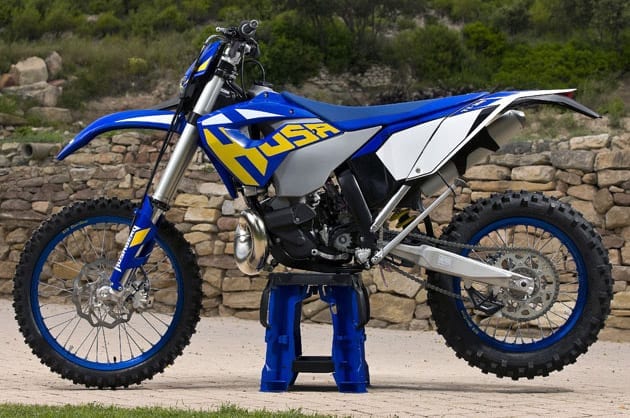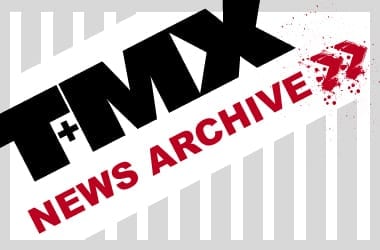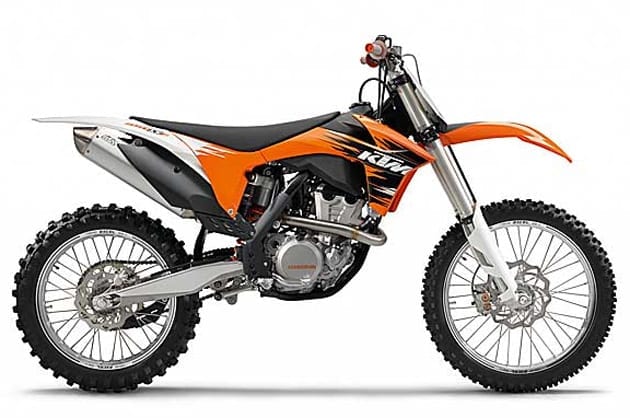Husaberg TE 250
By TMX Archives on 30th Jul 10

Forget everything you thought you knew about Husaberg being a four-stroke only enduro manufacturer as the born in Sweden, built in Austria brand readies themselves to enter an exciting new era by branching out into the two-stroke market for 2011.
Introducing 250 and 300cc two-stroke TE models to stand alongside their FE 390, 450 and 570cc four-stroke bikes, in expanding into the two-stroke market Husaberg looks to attract new customers while benefiting from the ever-growing interest in two-stroke enduro machines
This might sound like a strange thing to say but Husaberg could well have just built the best production KTM EXC 300 available today!
Expanding their traditional four-stroke only enduro model range to include two strokes for the first time ever, Husaberg have essentially re-branded and upgraded KTM's '11 250 and 300cc two-stroke enduro bikes, and done a damn good job of it, too.
Fitting the hugely popular mid-sized two-stroke KTM machines with Husaberg's distinctive blue and yellow bodywork, it's the few subtle upgrades made to the bikes that separate the blue from the orange. With the bodywork and 11-litre fuel tank stripped away the new Husaberg two strokes are all but identical to the latest offerings from KTM. But there is one noteworthy difference - the suspension.
WP's 48mm closed cartridge front fork, along with setting changes to the rear PDS shock, is what will set Husaberg and KTM's 250 and 300cc two-stroke machines apart for '11. Admittedly it's not much of a difference, but the sportier damping offered largely by the closed cartridge fork does offer a small, but noticeable, improvement over the handling package of KTM's out of the crate mid-sized two-stoke machines.
Riding a 'new model' that's, well, not all that new due to the fact that KTM have already launched their 2011 enduro machines is certainly an unusual experience. Climbing onto a non four-stroke Husaberg was also a little strange at first, but knowing more or less exactly what the bikes would be like to ride before even turning a wheel was even stranger.
With most people needing little introduction to KTM's 250 and 300cc two strokes - bikes that dominate the production mid-sized two-stroke enduro market - the question most want answering has to be 'are Husaberg's new two-stroke any different to their equivalent KTMs, and if so in what way?' Making comparisons to KTM's '11 two strokes is unavoidable.
As far as most riders will be concerned they're not really any different at all. Yes, there are differences, subtle yet noticeable differences, but in using all the same components and products as are fitted to KTMs as standard the 'berg two strokes are near as damn it blue KTMs, which is certainly no bad thing. In fact that alone will almost certainly be enough to convince many the bikes are more than up for the job.
What does make them different is the fact that Husaberg have, by way of trying to not make the bikes exactly the same and wanting to add a premium touch, opted to up-rate the suspension slightly. Sticking with WP, as you'd expect, both the 250 and 300 come fitted with the closed cartridge front fork introduced last year on the FX 450.
Although set to be softer than on the cross-country model both the 'berg 250 and 300 do feel sportier than their equivalent KTM models. Not by a huge amount but by enough. Offering the same progressive action as the open cartridge fork the most notable difference is the bike's resistance to bottoming. Giving confidence to ride harder, and with more resistance to bottoming when riding at speed, the set-up is by no means 'racers only' as it retains much of the same feel as the open cartridge fork. The action of the shock, although said to be set different to that on the KTM, doesn't feel that much different but does exactly what it needs to do to ensure both Husaberg two-strokes remain balanced and well suspended.
Both two-stroke engines are the same as fitted to '11 model KTMs. The 250 is unquestionably the livelier of the two machines with a strong bottom-end and a much more revvy top-end than that of the 300. What the 250 has that the 300 doesn't is a slightly disjointed spread of power. Not a problem when riding the bike hard, but when asking the motor to pull from bottom to top-end there's a noticeable hit when the power really kicks in. The 300 by contrast remains smoother throughout the rev range.
With the exact same brakes, clutch, wheels, in fact everything as a KTM, it's no surprise that the new Husaberg two strokes feel exactly the same as KTM's '01 and '011 models. With the fuel tank holding a mammoth 11 litres there's no additional width to either of the new 'bergs and both are extremely nimble.
Keeping the bikes simple and not fitting them with Electronic Fuel Injection will also please many as the bikes retain tried, understood, and tested carburettor technology and remain simple to work on. What would have been nice is if the bikes were in some way a little more unusual - a little more radical, just as the FE machines are compared to all other four-strokes.
As blue versions of KTM's hugely popular 250 and 300cc EXC machines it goes without saying that the new Husaberg's are an appealing, well proven, and reliable 'new' product, Husaberg will undoubtedly attract new customers to their brand with two excellent bikes.
With the 250 the racier of the two-stroke models and the 300 the smoother, stronger option, Husabergs have all areas of the mid-sized two-stroke market covered. With both models fitted with electric start, the lively and powerful 250 will, as has been seen with KTM, likely appeal to those geared more to competition while the more docile 300 is the perfect work horse for those looking for an uncompromising do-all machine.
Launching their new generation four-strokes in '08, Husaberg moved away from their previous 'Four Stroke Force' branding. With 'rideability' - or Husability as it's affectionately known in-house - the focus for the marketing of the new machines, the KTM owned company's goal was to develop four-strokes that would be as close as possible to two-strokes in terms of handling and rideability.
Recognising the fact that no matter how light and manoeuvrable a four-stroke is there will always be situations where two strokes hold an advantage, and with strong demand for two-strokes in many key markets, Husaberg have simply decided to 'go for it'.
Specification:

